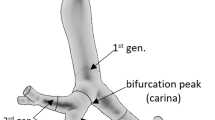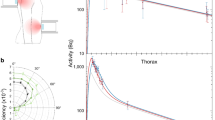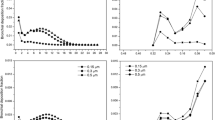Abstract
This paper provides absorbed doses arising from radon gas in air retained in lung airway lumens. Because radon gas exposure experiments often use small animals, the calculation was performed for mice and rats. For reference, the corresponding computations were also done for humans. Assuming that radon concentration in airway lumens is the same as that in the environment, its progeny’s production in and clearance from airways were simulated. Absorbed dose rates were obtained for three lung regions and the whole lung, considering that secretory and basal cells are sensitive to radiation. The results showed that absorbed dose rates for all lung regions and whole lung generally increase from mice to rats to humans. For example, the dose rates for the whole lung were 25.4 in mice, 41.7 in rats, and 59.9 pGy (Bq m−3)−1 h−1 in humans. Furthermore, these values were also compared with lung dose rates from two other types of exposures, that is, due to inhalation of radon or its progeny, which were already reported. It was confirmed that the direct inhalation of radon progeny in the natural environment, which is known as a cause of lung cancer, results in the highest dose rates for all species. Based on the present calculations, absorbed dose rates of the whole lung from radon gas were lower by a factor of about 550 (mice), 200 (rats), or 70 (humans) than those from radon progeny inhalation. The calculated dose rate values are comparatively small. Nevertheless, the present study is considered to contribute to our understanding of doses from inhalation of radon and its progeny.


Similar content being viewed by others
References
Asgharian B, Hofmann W, Miller FJ (2001) Mucociliary clearance of insoluble particles from the tracheobronchial airways of the human lung. J Aerosol Sci 32:817–832
Butterweck G, Schuler Ch, Vezzù G, Müller R, Marsh JW, Thrift S, Birchall A (2002) Experimental determination of the absorption rate of unattached radon progeny from respiratory tract to blood. Radiat Prot Dosim 102:343–348
Darby S, Hill D, Auvinen A, Barros-Dios JM, Baysson H, Bochicchio F, Deo H, Falk R, Forastiere F, Hakama M, Heid I, Kreienbrock L, Kreuzer M, Lagarde F, Mäkeläinen I, Muirhead C, Oberaigner W, Pershagen G, Ruano-Ravina A, Ruosteenoja E, Rosario AS, Tirmarche M, Tomásek L, Whitley E, Wichmann H-E, Doll R (2004) Radon in homes and risk of lung cancer: collaborative analysis of individual data from 13 European case-control studies. Br Med J 330:223–228
Desrosiers A, Kenedy A, Little JB (1978) 222Rn daughter dosimetry in the Syrian golden hamster lung. Health Phys 35:607–623
Fakir H, Hofmann W, Caswell R (2008) Radon progeny microdosimetry in human and rat bronchial airways: the effect of crossfire from the alveolar region. Radiat Prot Dosim 130:149–161
Harley NH (1988) Radon daughter dosimetry in the rat tracheobronchial tree. Radiat Prot Dosim 24:457–461
Harley NH, Meyers OA, Robbins ES (1992) 222Rn dosimetry in the dog lung. Radiat Prot Dosim 45:611–618
Henshaw DL, Eatough JP, Richardson RB (1990) Radon as a causative factor in induction of myeloid leukaemia and other cancers. Lancet 335:1008–1012
Hofmann W, Ménache M, Graham RC (1993) Radon progeny dosimetry in the rat lung. Health Phys 64:279–290
International Commission of Radiation Units and Measurements (ICRU) (1993) Stopping powers and ranges for protons and alpha particles. ICRU Report 49. ICRU, Bethesda
International Commission on Radiological Protection (ICRP) (1981) Limits for inhalation of radon daughters by workers. ICRP Publication 32. Ann ICRP 6
International Commission on Radiological Protection (ICRP) (1994) Human respiratory tract model for radiological protection. ICRP Publication 66. Ann ICRP 24
International Commission on Radiological Protection (ICRP) (2007) The 2007 recommendation of the international commission on radiological protection. ICRP Publication 103. Ann ICRP 37
Ishimori Y, Mitsunobu F, Yamaoka K, Tanaka H, Kataoka T, Sakoda A (2011) Performance of the first Japanese large-scale facility for radon inhalation experiments with small animals. Radiat Prot Dosim 146:31–33
Kataoka T, Sakoda A, Ishimori Y, Toyota T, Nishiyama Y, Tanaka H, Mitsunobu F, Yamaoka K (2011) Study of the response of superoxide dismutase in mouse organs to radon using a new large-scale facility for exposing small animals to radon. J Radiat Res 52:775–781
Khursheed A (2000) Doses to systemic tissues from radon gas. Radiat Prot Dosim 88:171–181
Lubin JH, Boice JD Jr, Edling C, Hornung RW, Howe GR, Kunz E, Kusiak RA, Morrison HI, Radford EP, Samet JM, Tirmarche M, Woodward A, Yao SX, Pierce DA (1995) Lung cancer in radon-exposed miners and estimation of risk from indoor exposure. J Natl Cancer Inst 87:817–827
Markovic VM, Krstic D, Nikezic D (2009) Gamma and beta doses in human organs due to radon progeny in human lung. Radiat Prot Dosim 135:197–202
Markovic VM, Stevanovic N, Nikezic D (2011) Doses from beta radiation in sensitive layers of human lung and dose conversion factors due to 222Rn/220Rn progeny. Radiat Environ Biophys 50:431–440
Markovic VM, Krstic D, Nikezic D, Stevanovic N (2012) Doses from radon progeny as a source of external beta and gamma radiation. Radiat Environ Biophys 51:391–397
Marsh JW, Birchall A (1999) Determination of lung-to-blood absorption rates for lead and bismuth which are appropriate for radon progeny. Radiat Protect Dosim 83:331–337
Monchaux G, Morlier JP, Morin M, Chameaud J, Lafuma J, Masse R (1994) Carcinogenic and cocarcinogenic effects of radon and radon daughters in rats. Environ Health Perspect 102:64–73
Monchaux G, Morlier JP, Altmeyer S, Debroche M, Morin M (1999) Influence of exposure rate on lung cancer induction in rats exposed to radon progeny. Radiat Res 153:S137–S140
Oldham MJ, Robinson RJ (2007) Predicted tracheobronchial and pulmonary deposition in a murine asthma model. Anat Rec 290:1309–1314
Peterman BF, Perkins CJ (1988) Dynamics of radioactive chemically inert gases in the human body. Radiat Prot Dosim 22:5–12
Raaschou-Nielsen O, Andersen CE, Andersen HP, Gravesen P, Lind M, Schüz J, Ulbak K (2008) Domestic radon and childhood cancer in Denmark. Epidemiology 19:536–543
Sakoda A, Ishimori Y, Kawabe A, Kataoka T, Hanamoto H, Yamaoka K (2010) Physiologically based pharmacokinetic modeling of inhaled radon to calculate absorbed doses in mice, rats, and humans. J Nucl Sci Technol 47:731–738
Sakoda A, Ishimori Y, Fukao K, Yamaoka K, Kataoka T, Mitsunobu F (2012) Lung dosimetry of inhaled radon progeny in mice. Radiat Environ Biophys 51:425–442
United Nations Scientific Committee on the Effects of Atomic Radiation (UNSCEAR) (2009) Annex E. Sources-to-effects assessment for radon in homes and workplaces. UNSCEAR 2006 Report to the General Assembly, with Scientific Annexes. United Nations, New York
Yeh HC, Schum GM (1980) Models of human lung airways and their application to inhaled particle deposition. Bull Math Biol 42:461–480
Yeh HC, Schum GM, Duggan MT (1979) Anatomic models of tracheobronchial and pulmonary regions of the rat. Anat Rec 195:483–492
Author information
Authors and Affiliations
Corresponding author
Rights and permissions
About this article
Cite this article
Sakoda, A., Ishimori, Y., Yamaoka, K. et al. Absorbed doses of lungs from radon retained in airway lumens of mice and rats. Radiat Environ Biophys 52, 389–395 (2013). https://doi.org/10.1007/s00411-013-0478-5
Received:
Accepted:
Published:
Issue Date:
DOI: https://doi.org/10.1007/s00411-013-0478-5




